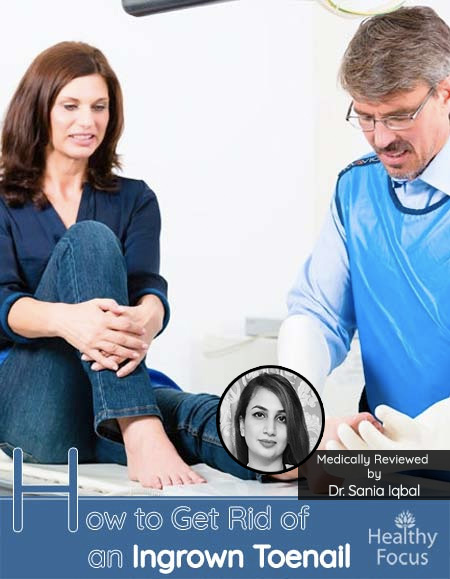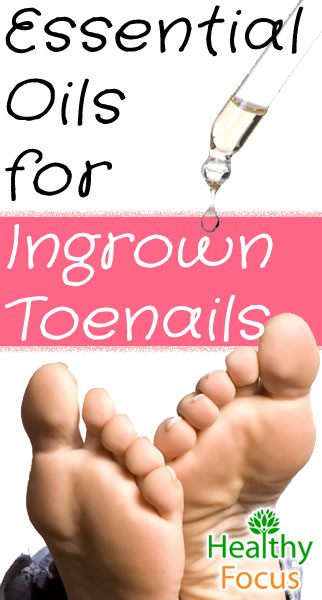Last Updated on September 2, 2023 by Marc Seward
Anyone who has ever had ingrown toenails knows how annoying and painful they can be. Personally, I have dealt with this issue since I was a kid. Eventually it required surgery but with some early detection and proper home treatment, you can avoid my fate.
Ingrown toenails are actually a common condition, known as “onychocryptosis” or “Unguis Incarnates” medically. If not taken care of properly, ingrown toenails will require medical intervention. It is better to treat the condition early and take steps to make sure it does not get worse.
If you ignore the ingrown toenail or hope it will just go away– it will only get worse and likely lead to an infection.
There are many powerful natural home remedy options to deal with ingrown toenails and related foot problems. With careful treatment, you can prevent and even fight off related infections.
Below I will review the typical causes as well as the best home remedies to get rid of ingrown toenails.
What causes Ingrown Toenails?
Ingrown nails can form on any of your toes or fingers, though it usually affects the big toe. Some people have nails that curve or grow downward making them more vulnerable to develop ingrown nails. Stubbing your toe badly or having your foot stepped on can also cause the nail to curve towards the skin.
You cannot change the way your nail grows but you can address preventable factors.
Preventable factors include
- Improper trimming and cutting of the toes – Toenails should be cut in a straight line.If the nails are cut too short or the corners are rounded, they are more likely to dig in to the skin. If you pick or tear at the edges of the nails this can also cause ingrown toenails.
- Poor fitting shoes –Shoes that are simply too tight, shoes with high heels, and shoes that are pointed or narrow toed can all be contributing factors. Narrow shoes put the toes under an excessive amount of pressure and may force the nails to grow into the skin.
- Infections –Bacterial and fungal infections can change the nail making it thicker and wider. Viral infections can cause warts under the nail and skin changing the shape of the nail.
- Injury – Even simple injuries like stubbing your toe or getting it stepped on can make it grow incorrectly.
- Diabetes – If your ingrown nails are linked to a diabetic condition, you need to be extra careful and get medical guidance. It would be a good idea to visit a podiatrist. Small cuts and abrasions can result in serious complications, so it is essential to check your toes daily.People who have diabetes and vascular problems also have diminished sensation in their feet. Typically, this means ingrown toenail detection happens later leading to a greater risk of infection.
Typical Ingrown Toenail symptoms
Unless you have diminished sensation or a loss of feeling in the toes, it is hard to miss the signs of an ingrown toenail.
- Pain in and around the toenail area.
- Redness and swelling.If the toenail is infected, you may see a yellow or watery discharge and may have traces of blood.
OK, I have or am developing an ingrown toenail, now What?
How to Get Rid of an Ingrown Toenail
Soaking your feet
Warm water footbaths form the base treatment for most remedies. The bath softens and loosens the nail and surrounding skin providing temporary relief and aiding in other treatments.
Foot bath tips:
Soak your feet regularly with warm or hot water. Try and do foot baths 2 to 3 times daily for 15-20 minutes.
For the best results, add these remedies to your bath:
Epsom salt – Epsom salt reduces inflammation and swelling and softens the surrounding skin. This helps the toenail grow out instead of inward. Put in a tablespoon or two of Epsom salt into your footbath.
Hydrogen Peroxide – Add a half of a cup of 3% hydrogen peroxide into your footbath. Hydrogen Peroxide softens your skin and nail and also prevents and fights infections.
Apple cider vinegar (ACV) Add a few tablespoons of raw ACV to your footbath. The Acetic acid in the vinegar softens nails and fights infections.
You can also drink it. Ingesting ACV can provide many general health benefits and assist fighting off infection. When drinking ACV use a straw or rinse your mouth with water after drinking. ACV can damage tooth enamel because of its high acid content.
You can also try physical interventions with a cotton ball or dental floss.
After soaking your feet try the following:
- Take a small bit of cotton or cotton ball and roll it out, so you get yourself a small thin roll.
- Carefully lift the nail and place the roll between your nail and your skin. This may be very painful but it elevates the toenail and prevents it from growing in.
- Carefully lift the nail and place the roll between your nail and your skin. This may be very painful but it elevates the toenail and prevents it from growing in.
- Leave the roll in until the next soaking.
Change the roll after soaking and try and push it in farther each time.
An alternative I prefer to cotton balls is dental floss. I suggest one like “Glide”. It is thinner, less likely to get stuck, wax coated and easier to get under your toenail. It is much less painful and more effective.
Topical treatments for Ingrown Toenails
Additionally, you can apply treatments directly on the affected area. Typically, they will soften the nail and will help prevent infection.
Apple cider vinegar – pour some raw ACV on a cotton ball and dab onto the toenail directly. Repeat twice daily.
Essential Oils for Ingrown Toenails
There are numerous essential oils to help relieve pain and stop infections. Put several drops on your toe or mix it with a carrier oil. This is a case where a few drops direct can be very effective.
Recommended oils and their benefits:
Eucalyptus oil
Is antibacterial, provides pain relief, and moisturizes skin and stimulates an immune response.
Tea tree oil
Tea Tree Oil has strong anti-bacterial and especially powerful anti-fungal properties. Plenty of research has been done to demonstrate its ability to inhibit the growth of fungus and bacteria of many different types. If you are serious about home treatments, tea tree oil is firmly in the ‘must have’ category.
Lavender oil
Lavender essential oil is a firm favorite among oil enthusiasts because of its gentle action and the remarkable variety of ailments both emotional and physical that it can treat. Lavender gets much of its use from its powerful antibacterial and anti-fungal qualities which can treat and prevent a host of infections when applied to the skin. It is also anti-inflammatory and improves blood circulation.
Peppermint oil
This menthol based essential oil is known for its cooling and healing effects and can be used as an effective remedy for your ingrown toenails much like commercial menthol based rubs. Peppermint oil has antiseptic and antibacterial properties which help destroy any infection while also softening the nail allowing it to be removed more comfortably. Peppermint essential oil also provides pain relieving qualities allowing you to go about your day in comfort.
Other Oil options for ingrown toenails
Coconut oil
Coconut oil is a wonderful option for the skin and for the nails. We are not talking about just any coconut oil here, rather good quality virgin coconut oil which contains fatty acids that have anti-bacterial, anti-viral and anti-fungal properties.
Basically coconut oil is brim full of beneficial medium chain fatty acids. These fatty acids which include lauric and caprylic acids get metabolized in the body and become powerful anti-fungal and antibacterial compounds. These acids also have the benefit of permeating the skin with ease where they begin to really take effect.
It is also a very effective anti-inflammatory and coconut oil is becoming increasingly well regarded for its abilities to treat a variety of chronic skin complaints with eczema and psoriasis among them. It is extremely safe, natural and healthy and keeps well for a long period of time without becoming rancid.
Coconut oil comes highly recommended for the treatment of your ingrown toenails as well as other foot conditions like nail fungus, cracked heels and athlete’s foot.
Apply a generous helping of virgin coconut oil to your ingrown toenail twice a day and you should soon start seeing great results.
Natural Remedies for Ingrown Toenails
Lemon
Cut a thin slice of lemon and secure it to the nail with a bandage or gauze. Plain lemon juice can be used as well. Leave it in overnight. This treatment is especially useful if you have an infection. The acidity of the lemon helps fight infection and kill bacteria.
Turmeric
Turmeric contains a compound known as curcumin which is responsible for its beautiful color. But curcumin is not only aesthetically pleasing, it also has powerful antimicrobial properties which is why turmeric is so often recommended as a home treatment. As well as being able to destroy infection, turmeric also has anti-inflammatory abilities and is a great home treatment option for your ingrown toenails.
To use turmeric on your toes, you will need to first make it into a paste by mixing 2 teaspoons of turmeric into an equal amount of water or mustard oil. Mix it well until you have a nice smooth paste and then apply it to your affected toes each day until your symptoms have subsided.
Ginger
Another spice with excellent healing properties is ginger which like turmeric can be mixed into a paste to treat your ingrown toenails. Mix 2 teaspoons of ginger powder with an equal quantity of water until it forms a smooth paste and apply it to your toenail twice or 3 times daily.
Another option is to combine a teaspoon of cayenne pepper and the same amount of sesame oil with 4 teaspoons of ginger oil and apply the mixture several times a day.
The OTC options:
There are a few OTC creams you can turn too if the natural cures do not work.
Antibiotic ointments
Bacitracin or Neosporin. These powerful ointments can kill infections.
Menthol
Via Vicks VapoRub- This cold remedy may also offer some relief for the ingrown toenail since it softens the nail so that you can remove it the next day. Menthol is also an antiseptic that may kill any infection. Apply the menthol directly on the nail to help with healing and pain. Put the VapoRub on the toenail and cover with a bandage overnight.
Free your feet!
It is better to go barefoot or at least bare-toed for a few days to allow the toe to heal. In warm weather especially, make sure to limit wearing shoes when possible. Afterwards, wear comfortable shoes that provide your toes enough room, and cut your toenails properly to prevent another ingrown nail.
- If the problem persists or you see signs of infection, immediately seek medical attention.
I hope that one of these remedies will prove useful to alleviate your ingrown toenail. The bottom line is you have a number of great options to naturally and affordably take care of ingrown toenails and avoid the knife.



Leave a Reply
You must be logged in to post a comment.